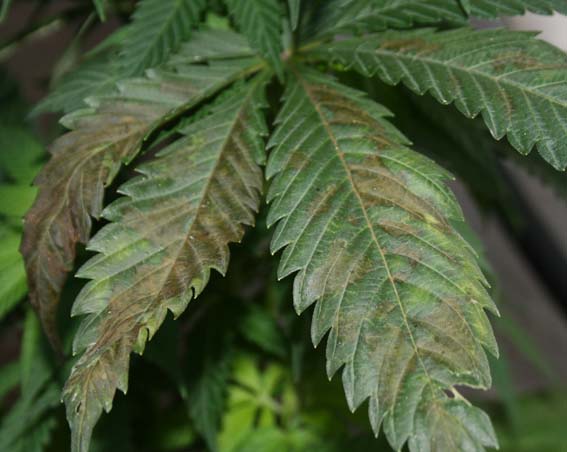
Mildew
Plasmopara Viticola
Pathogen:
Oomycete
Type:
Risk:
INTERMEDIATE





DESCRIPTION
Pathogen description
Downy mildew is a disease caused by fungi of the genus Peronospora, one of the most common being Peronospora sparsa. This pathogen affects a wide variety of plants, including cannabis. It manifests itself as pale yellow Taches on the leaves, which eventually turn into necrotic Taches surrounded by a yellow halo, and finally into a powdery white mold on the underside of the leaves.
Disease description
In cannabis, downy mildew can cause yellow Taches on the leaves, which then turn brown and necrotic. These Taches can spread quickly, covering large areas of the plant. Additionally, a white, powdery mold can be seen on the underside of infected leaves, indicating an advanced infestation.

TEMPERATURE AND HUMIDITY
15°C - 25°C
80% - 95%

VOIES DE TRANSMISSION
Wind, raindrops, direct contact with infected plants, transportation of contaminated plant material.

Chemical treatments
CONTROL
• ORANGE OIL 6% [SL] P/V
• ORANGE OIL 60g/L [ME] P/S
• AZOXISTROBIN 25% [SC] P/V
• COS-OGA 1.25% [SL] P/V
• FOSETIL-AL 80% [WG] P/P
• POTASSIUM PHOSPHONATES 51% (Exp. as phosphorous acid) [SL] P/V
• CUPRIC HYDROXIDE 13.6% (EXPR. IN CU) + COPPER OXYCHLORIDE 13.6% (EXPR. IN CU) [SC] P/V
• LAMINARIN 4.5% [SL] P/S
• MANDIPROPAMID 25% [SC] P/V
Treatments authorized in organic farming
• ORANGE OIL 6% [SL] P/V
• ORANGE OIL 60g/L [ME] P/S
• COS-OGA 1.25% [SL] P/V
• CUPRIC HYDROXIDE 13.6% (EXPR. IN CU) + COPPER OXYCHLORIDE 13.6% (EXPR. IN CU) [SC] P/V
• LAMINARIN 4.5% [SL] P/S
Biological control
-
Preventive treatments
• AZOXISTROBIN 25% [SC] P/V
• FOSETIL-AL 80% [WG] P/P
• POTASSIUM PHOSPHONATES 51% (Exp. as phosphorous acid) [SL] P/V
• CUPRIC HYDROXIDE 13.6% (EXPR. IN CU) + COPPER OXYCHLORIDE 13.6% (EXPR. IN CU) [SC] P/V
• LAMINARIN 4.5% [SL] P/S
• MANDIPROPAMID 25% [SC] P/V
To prevent and control mildew in cannabis crops, it is recommended to implement preventive measures such as maintaining good soil drainage, avoiding excess watering and high humidity, and providing adequate air circulation around the plants. Crop rotation and removal of infected plants are also advised to prevent the spread of the pathogen.
Recommendations
*The recommended treatments are recommendations based on the authorities' databases and do not replace in any way the guidelines established by the legislation of each country.





